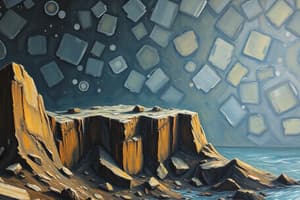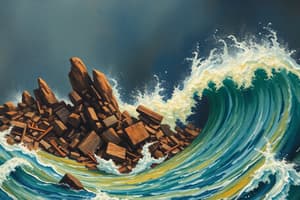Podcast
Questions and Answers
What is the purpose of plotting lag time in seismology?
What is the purpose of plotting lag time in seismology?
- To compare different earthquakes
- To estimate the Richter magnitude of an earthquake (correct)
- To measure the amplitude of seismic waves
- To determine the distance of seismic waves from the epicenter
How is the strength of an earthquake quantified?
How is the strength of an earthquake quantified?
- By the Richter magnitude (correct)
- By the intensity of the seismic waves
- By the distance covered by seismic waves
- By the duration of the tremors
Which part of the plotted graph indicates the estimated Richter magnitude?
Which part of the plotted graph indicates the estimated Richter magnitude?
- The intersection of the connected points with the middle scale (correct)
- The rightmost line measuring amplitude
- The leftmost line representing the lag time
- The slope of the graph
What information can be derived from a seismogram record?
What information can be derived from a seismogram record?
What does the term 'lag time' refer to in seismology?
What does the term 'lag time' refer to in seismology?
What generates an earthquake?
What generates an earthquake?
What role do seismic waves play in earthquake studies?
What role do seismic waves play in earthquake studies?
How do faults contribute to the occurrence of earthquakes?
How do faults contribute to the occurrence of earthquakes?
What is the significance of the 1991 Mt. Pinatubo eruption in the Philippines?
What is the significance of the 1991 Mt. Pinatubo eruption in the Philippines?
Which statement best describes the relationship between tectonic plate movements and earthquakes?
Which statement best describes the relationship between tectonic plate movements and earthquakes?
What often happens to buildings during water splashes caused by natural disasters?
What often happens to buildings during water splashes caused by natural disasters?
Which phenomenon may occur alongside massive landslides during disastrous water splashes?
Which phenomenon may occur alongside massive landslides during disastrous water splashes?
What is one of the major effects of completely devastating natural disasters on landscapes?
What is one of the major effects of completely devastating natural disasters on landscapes?
What happens to trees as a result of devastating water splashes?
What happens to trees as a result of devastating water splashes?
What often occurs to sewer pipes during natural disasters related to water splashes?
What often occurs to sewer pipes during natural disasters related to water splashes?
What is the nature of the Richter scale?
What is the nature of the Richter scale?
How much increase in amplitude does an increase of 1 unit on the Richter scale represent?
How much increase in amplitude does an increase of 1 unit on the Richter scale represent?
Which statement about microearthquakes is true according to the scale provided?
Which statement about microearthquakes is true according to the scale provided?
What is the average occurrence of minor earthquakes globally?
What is the average occurrence of minor earthquakes globally?
What intensity is associated with minor earthquakes on the Richter scale?
What intensity is associated with minor earthquakes on the Richter scale?
Which scale measures the intensity of shaking from an earthquake?
Which scale measures the intensity of shaking from an earthquake?
What type of earthquakes are categorized as 'micro'?
What type of earthquakes are categorized as 'micro'?
What is the key factor that the Richter scale is determined by?
What is the key factor that the Richter scale is determined by?
Which of the following is NOT a type of seismic wave?
Which of the following is NOT a type of seismic wave?
How do Rayleigh waves propagate?
How do Rayleigh waves propagate?
What is the primary method used to locate earthquake epicenters?
What is the primary method used to locate earthquake epicenters?
Which seismic wave is known for causing the most destruction?
Which seismic wave is known for causing the most destruction?
Which seismic waves can travel through both solids and liquids?
Which seismic waves can travel through both solids and liquids?
What characterizes S waves compared to P waves?
What characterizes S waves compared to P waves?
In terms of seismic wave propagation, what does the term 'slip' refer to?
In terms of seismic wave propagation, what does the term 'slip' refer to?
What behavior characterizes oblique seismic waves?
What behavior characterizes oblique seismic waves?
Flashcards are hidden until you start studying
Study Notes
Lag Time & Earthquakes
- Lag time in seismology is the difference in arrival times between P waves (primary waves) and S waves (secondary waves) at a seismograph station.
- Earthquake strength is measured using the Richter scale, which quantifies the magnitude of an earthquake.
- The estimated Richter magnitude is indicated by the difference in arrival times between P and S waves on a seismogram.
- Seismogram records provide information about earthquake timing, location, magnitude, and the type of seismic waves generated.
Earthquake Causes and Impacts
- Earthquakes are caused by the sudden release of energy within the Earth's crust, usually along fault lines where tectonic plates meet.
- Seismic waves are generated during earthquakes and are responsible for the ground shaking experienced.
- Faults are fractures in the Earth's crust where rocks have moved past each other, creating zones of weakness that can lead to earthquakes.
- Tectonic plate movements are directly related to earthquakes, as the movement of plates causes stress and pressure that eventually result in the release of energy.
- The 1991 Mount Pinatubo eruption in the Philippines had a significant impact on the global atmosphere.
- Buildings are often damaged during water splashes caused by natural disasters, due to erosion and structural collapse.
- Massive landslides can occur alongside water splashes during natural disasters, significantly altering landscapes.
- Devastating natural disasters can cause widespread landscape changes, such as erosion, landslides, and sedimentation.
- Trees are often uprooted or damaged by devastating water splashes, altering their growth patterns and forest ecosystems.
- Sewer pipes frequently break or become damaged during natural disasters related to water splashes, impacting sanitation systems.
Seismic Waves & Earthquake Measurement
- The Richter scale is a logarithmic scale used to measure the magnitude of earthquakes, with each unit representing a tenfold increase in amplitude.
- Microearthquakes are earthquakes with magnitudes less than 3.0.
- Minor earthquakes occur almost daily globally, with magnitudes ranging from 3.0 to 3.9.
- The Modified Mercalli Intensity Scale measures the intensity of shaking from an earthquake, based on its effects on people and structures.
- Microearthquakes are earthquakes with magnitudes less than 3.0, categorized as very small.
- The Richter scale is determined by the amplitude of the largest seismic wave recorded on a seismogram.
- Love waves are surface waves, also known as L-waves, which travel along the Earth's surface and are characterized by their horizontal displacement in a perpendicular direction to their propagation.
- The triangulation method is used to locate earthquake epicenters by measuring the difference in arrival times of P and S waves at various seismograph stations.
- Surface waves (Rayleigh and Love waves) are responsible for the most destruction during earthquakes.
- P waves are compression waves that can travel through both solids and liquids, while S waves are shear waves that can only travel through solids.
- S waves are slower than P waves and have a different motion, with particles moving perpendicular to the direction of wave propagation.
- Slip refers to the movement of rock masses along a fault during an earthquake, resulting in the release of energy that generates seismic waves.
- Oblique seismic waves combine compressional and shear motion, causing a complex movement pattern that can be challenging to predict.
Studying That Suits You
Use AI to generate personalized quizzes and flashcards to suit your learning preferences.




